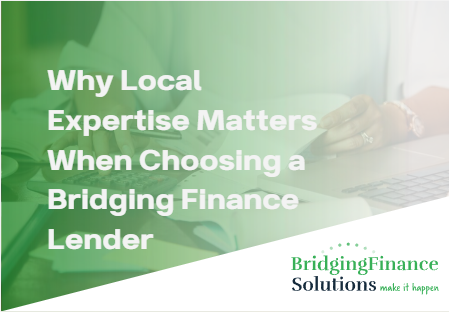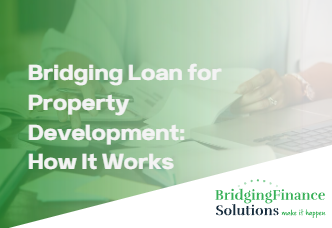From an early age, we all have ideas about our dream homes, from the layout to the number of bedrooms they’d have. Unfortunately, in the UK, especially, it can be challenging to find a property that meets your needs.
For this reason, many people are opting to build their own homes, allowing them to create their dream homes without compromise. As you might imagine, building your own house from the ground up is an expensive task.
If you would like to build your own property and do not already have the necessary funds, it is likely that you will need to turn to a financing solution.
At Bridging Finance Solutions, we have helped countless developers and individuals make a new home a reality. Keep reading to find out how we can help you.
Why Traditional Mortgages Fall Short For Self-Builds
The first mistake many developers make is believing they can obtain a traditional mortgage to finance their self-builds.
Traditional mortgages are not the best fit, primarily due to the construction method used for self-built homes. Typically, a phased approach is utilised, necessitating funds at various stages. This model conflicts with how mortgages operate, as they are often provided as a lump sum for completed properties.

Self-builds are also often perceived as riskier, as there is an ongoing risk of costs being incurred or operations not running as smoothly as initially predicted. Though a project may seem straightforward upon inception, that doesn’t necessarily mean it will stay that way for the duration.
For all of these reasons, anyone who builds a home from the ground up will rarely be eligible or accepted for a traditional mortgage.
Keep Self-Build Finance Options
Although you may not be eligible for a traditional mortgage to fund your self-build property, that does not mean that you are without options.
Some additional self-build finance options that you should consider include:
Self-Build Mortgages
A self-build mortgage is tailored for individuals constructing a property from scratch or undergoing significant renovations. In contrast to traditional mortgages that disburse funds in a lump sum, self-build mortgages offer funds in phased payments that correspond to the building process.
The process of building a house is broken up into several phases, and these include;
- Buying the plot.
- Laying the foundations.
- Erecting the walls.
- Adding the roof.
- Attending to electrical needs and plumbing.
- Property completion.
Though self-built mortgages are catered to the self-build journey, they are not without complications. For example, there are strict eligibility and underwriting criteria, so many people may not even be able to secure the loan, and you are at the discretion of the self-build mortgage lender.
These self-build mortgages are rapidly growing in popularity; however they are quite slow to arrange and may require multiple valuations before they are accepted. If you need fast cash to bridge the gap during the building process, self-build mortgages may not be the best option.
Remortgaging an Existing Property
If you already own a property, you can obtain the necessary funds by remortgaging your property and releasing the funds. Remortgaging your existing property is a great way to secure a lump sum that can be used to buy land, pay contractors, and cover any costs you may incur during the early stages of building.
This can be an incredibly cost-effective way to secure finance if you are met with favourable mortgage rates. However, there is a lot of risk involved in going down this route, and you may compromise the safety of your current property.
Remortgaging can also be a lengthy process, which can be inconvenient if you need funds quickly.
Savings and Investments
If you have accumulated savings or possess liquid assets, these can serve as the basis for your self-build budget. Often, lenders prefer to verify that you are personally invested in the project, particularly during the initial phases.
If you have the resources to be able to fund your development this way, it is definitely recommended that you follow this route, as it allows you to avoid repayment and potential interest.

However, this payment method comes with a significant risk, and if you fail to generate the returns you expect, you may risk completely depleting your financial safety net. As we have also touched on, there may be unexpected bills during the process that you have not planned for, so if you don’t have a backup funding solution, you could find yourself in a difficult situation.
For this financing solution to work, you need to have substantial savings to fall back on.
Development Finance Loans
Development Finance loans provide a short-term financing option aimed at closing the gap between your urgent capital requirements and a longer-term exit strategy. These loans are ideal for self-build properties, as they are designed to be quick, flexible and accessible.
At Bridging Finance Solutions, we have provided the necessary finances to help make it happen for a range of self-builds, so we know just how effective this finance can be.
Development loans can be used to cover every step of your process and can cover you in case you need additional, unexpected funding. Thanks to the fast pace and flexibility of these loans, you can get the necessary finance in a matter of days, keeping your project on track, even when problems arise.
Benefits of Development Finance Loans for Self-Build Projects
When it comes to self-build home funds, development finance loans are the obvious choice. Though you have to contend with interest rates and shorter repayment periods, this all pays off in the end. Some benefits include:
Fast Turnaround
Developing a property can be a fast process. Even though it can feel like you have waited forever for the ideal plot of land to open up, once it has, it’s all systems go. You must act quickly, as delays in finance can result in missing out.
Thankfully, if you choose to take out a development finance loan for your self-build project, you have the reassurance that you can have the money within an agreed timetable. Having access to this quick turnaround can give you a competitive edge and ensure that you can get construction underway as soon as possible.
Flexible Terms
No two self-build projects are the same, and given the scale of your build, your property might be complete in a couple of months, or it could even take more than a year. While with other loans, you need to structure your build around the loan’s terms, development loans are structured around your project timeline.
Helps Fund Each Stage
When you’re building a property from the ground up, you are going to encounter costs at every step of the way. BFS can help you plan that expense, and you only pay interest on the funds used. Funding is often provided in arrears, and strict budgeting is essential to allow for your build to continue.
Costs of Self-Build Finance
When you take out any sort of loan, you must expect some costs. Self-build finance often comes with the following costs:
Interest Rates and Comparison
Self-build finance interest rates tend to be higher than those for standard residential mortgages, primarily because of the added risk and complexity. These rates can vary significantly among lenders and their products, making it essential to carefully compare offers.

Whether you opt for a self-build mortgage or a development finance loan, even a minor variation in interest rates can significantly affect the total loan cost over its duration.
Arrangement and Exit Fees
It is expected that lenders will charge an arrangement fee, which is often a percentage of the amount borrowed and may be deducted from the overall loan at the beginning of the loan. If you repay the loan faster than the first predicted, you will be expected to pay exit fees to make up for the interest the borrower would have received if you had seen the loan through to completion.
Before committing to any loan, make sure that you discuss these factors with your lender.
Valuation and Monitoring Costs
Due to the unpredictability of self-build properties, they often require valuation/QS reports at different stages of the build to ensure they are on track. Even if the property receives only one valuation, completing it incurs costs. Lenders always want to ensure that their money is being used as it was intended.
It is important to discuss these possible fees with your lender and iron out the details before making any agreements.
Overall Cost Considerations
When interest, fees, valuations, and additional charges are combined, the overall cost of borrowing for a self-build project can be substantial. It’s essential to look beyond the basic interest rates and evaluate the complete cost of financing throughout the loan’s duration.
A practical and thoroughly planned budget must consider all possible expenses to ensure financial sustainability for your project from start to finish. An experienced development finance provided such as Bridging Finance Solutions provide sound guidance and is FCA regulated.
What Lenders Expect From Self-Build Finance Applications
When applying for finance attention to detail prior to submission is essential. It speeds the process up significantly if all necessary information / documentation is readily available.
When reviewing an application, lenders expect to see the following:
Planning Permission
Planning permission is required for the vast majority of lenders prior to agreeing a loan.
If you want to get the best possible value for your loan and the best deal on interest rates, it is always better to have planning permission in place, as this will work in your favour.
Clear Build Schedule
Although providing a detailed build schedule is not always strictly required for a bridging loan, lenders prefer to see a plan in place when they invest in a project. This means you have a comprehensive timeline of all project aspects, from start to finish. They may also expect to know the costs of the project so that they can provide you with the necessary financing to cover the cost of your project.
Exit Strategy
Before you are even considered for a loan for your self-build, you will need to establish an exit strategy.
Having a clear exit strategy is crucial when seeking development finance. It demonstrates to the lender your plan for repaying the loan at the end of its short-term period, which usually ranges from 6 to 18 months. (maximum 12 months for regulated loans) Given that development loans are often interest-only and require full repayment at the end, lenders seek assurance of a sound repayment plan, such as selling a property, refinancing, or tapping into equity, to settle the outstanding amount.
Budget and Contingency Funds
Lenders expect to see a detailed budget and contingency funds because it demonstrates that you’ve carefully planned the project and are financially prepared for unexpected costs.

They also need to see a budget so they are aware of exactly how much financing they need to provide and how it will be used. A contingency fund is an essential part of any application because it shows that you are already planning for every possible contingency, which shows you are prepared and can be a trusted borrower.
How Bridging Finance Solutions Can Help
Through this blog, we hope to have provided you with more insight into the finance options for self-build projects. Development finance loans are the obvious choice for your self-build project.
If you are looking to start a self-build project, you need a development finance loan provider on your side who you can trust; you need Bridging Finance Solutions. Get in touch today to make it happen or fill out our application form.




